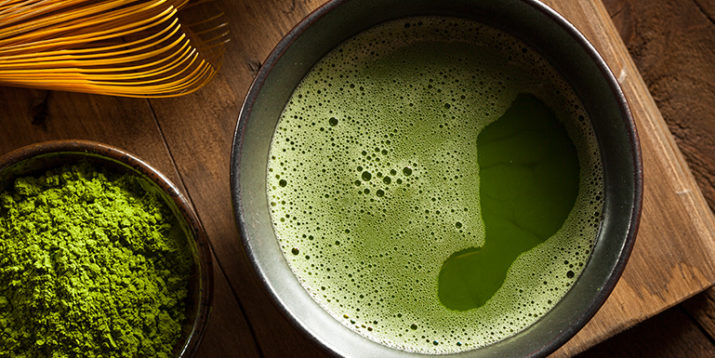What Is Matcha Tea?

I might be slightly obsessed with matcha. My coat pockets are stuffed with matcha mints. Matcha lattes are my sugary beverage of choice at a certain coffee chain. Do I want to add a matcha shot to my smoothie? Yes, please. There’s even a shout-out to green tea ice cream — flavored with matcha, of course! — in my BODi bio.
Until recently, though — and this is slightly embarrassing given how much matcha I consume — I didn’t actually know what matcha was. I mean, I knew it had something to do with green tea, and I vaguely remembered hearing that it was good for you. But really, I just like it because it’s delish — matcha has a sweet, grassy flavor and a frothy texture, which is a nice change from coffee.
What Exactly Is Matcha?
Matcha is the powdered form of green tea leaves. Pretty simple, huh?
Matcha and green tea differ in the way the tea leaves are processed. Green tea is made by harvesting, heating, and drying leaves from the Camellia sinensis plant. When the dried leaves are steeped in water, ta-da, you have tea. To make matcha, the leaves are kept in the shade for 10 to 20 days before they’re harvested. This can help boost their level of chlorophyll, a plant pigment that gives matcha a vibrant jade green color. After the leaves are harvested, they’re milled into a fine powder, which can then be whisked with hot water to make a frothy drink.
Because you’re consuming the entire leaf, the beneficial phytonutrients in matcha may be more potent than those in green tea — which could help explain why matcha is totally having its moment right now. (Also, it’s gorgeous. And delicious.)
You can buy matcha energy drinks and matcha soda at the grocery store. Many coffee and teashops now sell matcha tea ceremony sets. There are matcha marshmallows, matcha cupcakes, matcha energy balls, and matcha mochi. Ippodo, a matcha tea shop that has been around since 1717 in Kyoto, now has an outpost in New York, and recently, hipster-friendly matcha bars popped up in NYC and Silver Lake, California. (Seriously? Take all my money.)
So where did all the matcha hype start?
The History of Matcha
Matcha isn’t actually a new trend — it’s been around for about 900 years. In the 12th century, Zen monks brought tea from China to Japan. It’s believed that the dried tea leaves were pressed into a brick shape to make them easier to transport — so rather than steeping the leaves as usual, the monks broke off small pieces, ground them into powder, and mixed the powder with hot water.
That’s similar to how matcha is made today.
How to Make Matcha Tea
Brewing a basic cup of matcha is pretty simple.
- Scoop one or two teaspoons of matcha powder into a tea bowl. (Pouring it through a strainer can help remove clumps.)
- Pour 2 oz. of hot water — not quite boiling — over the matcha powder.
- Whisk the powder and water together. Fun fact: Whisking in a “W” pattern, rather than in circles, will make your matcha foamier.
- If you prefer thicker matcha — known as koichu — double up the amount of powder you use.
- Pour the mixture into a cup and enjoy.
What Are the Benefits of Matcha?
You’re probably already familiar with the potentially mood-boosting benefits and antioxidant effects of green tea — so what makes matcha different? Here are a few things this superfood (er, superdrink?) might be able to do for you:
- Increase Energy. Depending on how you prepare it, a cup of matcha can contain between 30–70 mg of caffeine. By comparison, a cup of black coffee contains just under 100 mg of caffeine — but devotees say matcha makes them much less jittery than coffee does. The buzz from matcha is often described as a state of “relaxed alertness.”
- Boost Brainpower. Struggling to stay focused? Like green tea, phytonutrients in matcha have been linked to improved concentration and clearer thinking – mostly thanks to the effects of caffeine.
- Support Relaxation. Matcha is a source of L-theanine, an amino acid that has been researched for its relaxing-promoting effects when you consume it in sufficient amounts.
Where Do I Buy Matcha? What Should I Look For?
Matcha is pretty easy to find these days — you can find it at health food stores and tea shops, but many big-box stores and supermarkets have started carrying it too. The easiest way to tell the difference between high-quality matcha and low-quality matcha is to look at the color — high-quality matcha should be vibrant green, not yellowish or brownish.
Expect to pay about $1 per gram for ceremonial-grade matcha — if you find an amazing bargain, you’re probably getting what you pay for. If you’re going to bake with it or use it in a recipe, non-ceremonial matcha will work just fine. Or, consider picking up a culinary-grade matcha.
How Can I Add Matcha to My Diet?
Note to self: Sugary snacks and syrupy drinks are not the ideal way to enjoy matcha.
Instead, BODi has created some excellent matcha recipes so you can get your matcha fix without the sugar rush. Oh, and did you know that matcha is an ingredient in our Shakeology Focused Energy Boost? Try a scoop of it in your Shakeology!
